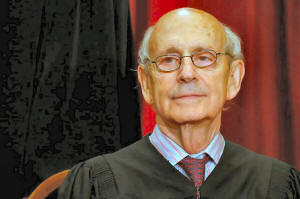|
Signs of struggles on big cases as U.S.
Supreme Court pace slackens
 Send a link to a friend
Send a link to a friend
 [April 09, 2018]
By Lawrence Hurley [April 09, 2018]
By Lawrence Hurley
WASHINGTON (Reuters) - Members of the U.S.
Supreme Court appeared to be struggling over how to resolve a key case
recently when Justice Stephen Breyer suggested that the best course
might be to put off a decision altogether.
Breyer's remark, coming during a March 28 oral argument in a closely
watched case involving the redrawing of electoral districts aimed at
entrenching one party in power, illustrated the difficulty the nine
justices seem to be having in producing rulings at their usual pace.
With five conservatives and four liberals, the court is ideologically
divided, meaning common ground may be difficult to find. President
Donald Trump's appointee Neil Gorsuch, who marks his first anniversary
as a justice on Tuesday, restored the court's conservative majority
after it was shorthanded and evenly split ideologically for 14 months.
During their current term that began in October and runs through the end
of June, the justices must resolve more weighty and difficult cases than
usual. One of their biggest cases -- deciding the legality of President
Donald Trump's travel ban on several Muslim-majority countries -- will
not be heard until April 25.

The high court has issued only 18 rulings in cases already argued this
term, lagging behind its normal pace. Numerous major cases have yet to
be resolved, including one on Wisconsin electoral boundaries heard in
October and the similar one heard last month involving the same practice
of "partisan gerrymandering" in Maryland that prompted Breyer to suggest
the justices rehear the whole matter in the future.
A divisive case pitting gay rights against religious liberty, involving
a Christian baker who refused to make a wedding cake for a gay couple,
was argued in December.
Other major cases involve fees paid by non-members to unions
representing public employees like police officers and teachers, the
right of workers to bring class-action claims against employers, the
ability of police to obtain cellphone location data to tie criminal
suspects to crimes and a California law regulating Christian-based
anti-abortion facilities.
Supreme Court experts expect the justices to issue a larger-than-normal
number of 5-4 rulings in the coming months. That would increase the
chances of conservative Justice Anthony Kennedy, who sometimes sides
with the court's four liberals in major cases, casting the deciding
votes.
"It's reasonable to suggest there are going to be fewer unanimous
decisions and more division," said Nicole Saharsky, a lawyer who often
has argued cases before the court.
The court usually takes less time in issuing a ruling when the justices
are unanimous. It has issued 11 unanimous rulings and seven with
dissenting votes, including three that were 5-4. The court's most
contentious rulings commonly are issued in June.
Part of the slowdown in rulings may be related to the presence of
Gorsuch, who has shown signs that he will be a strident conservative
voice on the bench. Gorsuch also has exhibited a willingness to question
the reasoning of his colleagues, a practice that can delay rulings.
[to top of second column]
|

U.S. Supreme Court Justice Stephen Breyer participates in taking a
new family photo with his fellow justices at the Supreme Court
building in Washington, D.C., U.S., June 1, 2017. REUTERS/Jonathan
Ernst

"There could just be new dynamics one way or another," said John
Elwood, who has argued multiple cases before the Supreme Court.
CONTENTIOUS ISSUES
The impasse over partisan gerrymandering was first on display when
the court heard arguments on Oct. 3 in a challenge by Democratic
voters to Republican-drawn state legislative districts in Wisconsin.
Five months later, the justices appeared no closer to resolving the
matter when they heard the similar Maryland dispute involving a
Democratic-drawn U.S. House of Representatives district.
The court seemed similarly divided in the worker class action case
argued on Oct. 2, the first day of the term. The justices will have
to decide whether workers can be forced by companies to sign
agreements waiving the right to bring class-action claims against
their employer.
Based on the Dec. 5 oral argument, Kennedy will also be the deciding
vote in the case of whether the Denver-area Christian baker can be
penalized under a Colorado anti-discrimination law or whether the
U.S. Constitution's promise of free speech protects him.
The nine justices have not always been at odds with each other, even
on contentious matters. There was no dissent when the court in
February rejected Trump's bid to immediately end a program that
protects hundreds of thousands of immigrants brought illegally into
the United States as children.
The court also showed no divisions when it declined to intervene in
another electoral boundaries fight, this time in Pennsylvania.


The slow pace of rulings may in part just be the result of
scheduling, said Kannon Shanmugam, another regular Supreme Court
lawyer.
"The court has had hard, divisive cases earlier in the term," he
said. "It's not surprising it might take a while."
(Reporting by Lawrence Hurley; Editing by Will Dunham)
[© 2018 Thomson Reuters. All rights
reserved.]
Copyright 2018 Reuters. All rights reserved. This material may not be published,
broadcast, rewritten or redistributed.
Thompson Reuters is solely responsible for this content. |